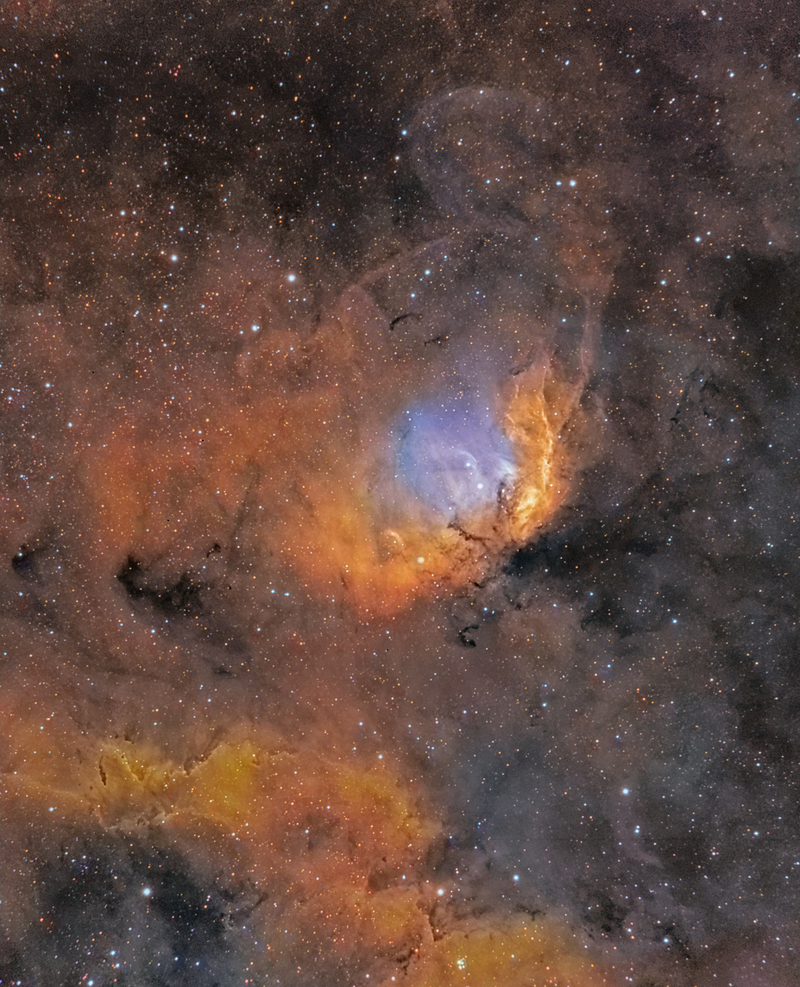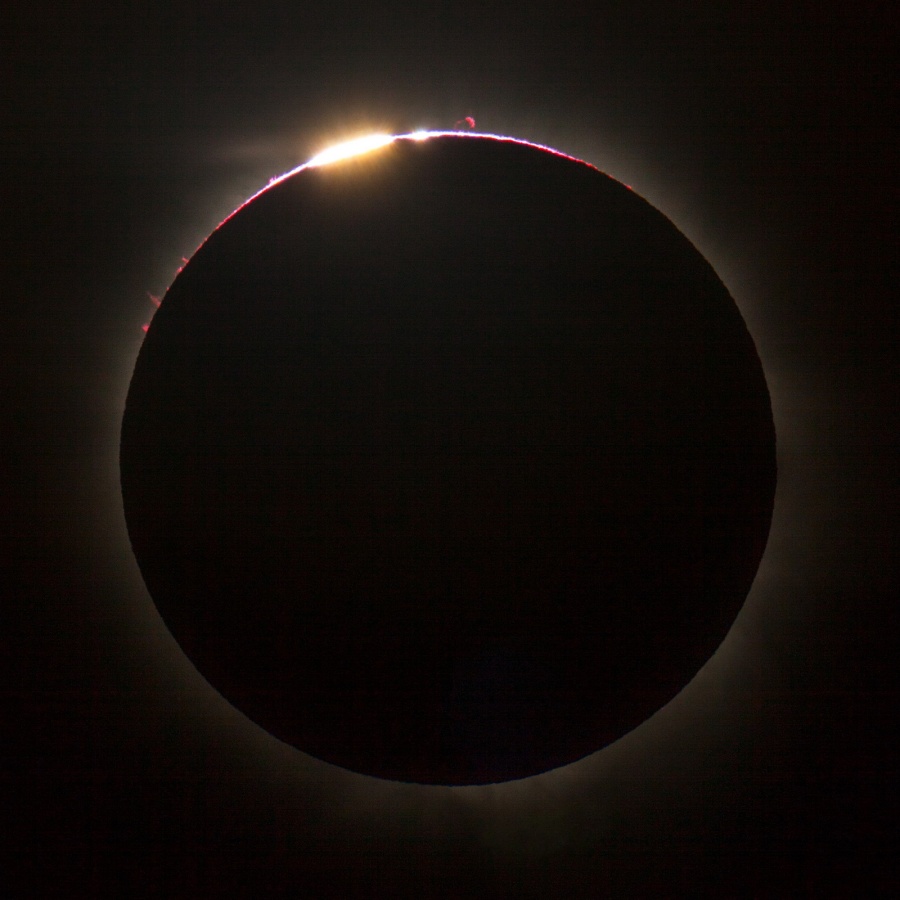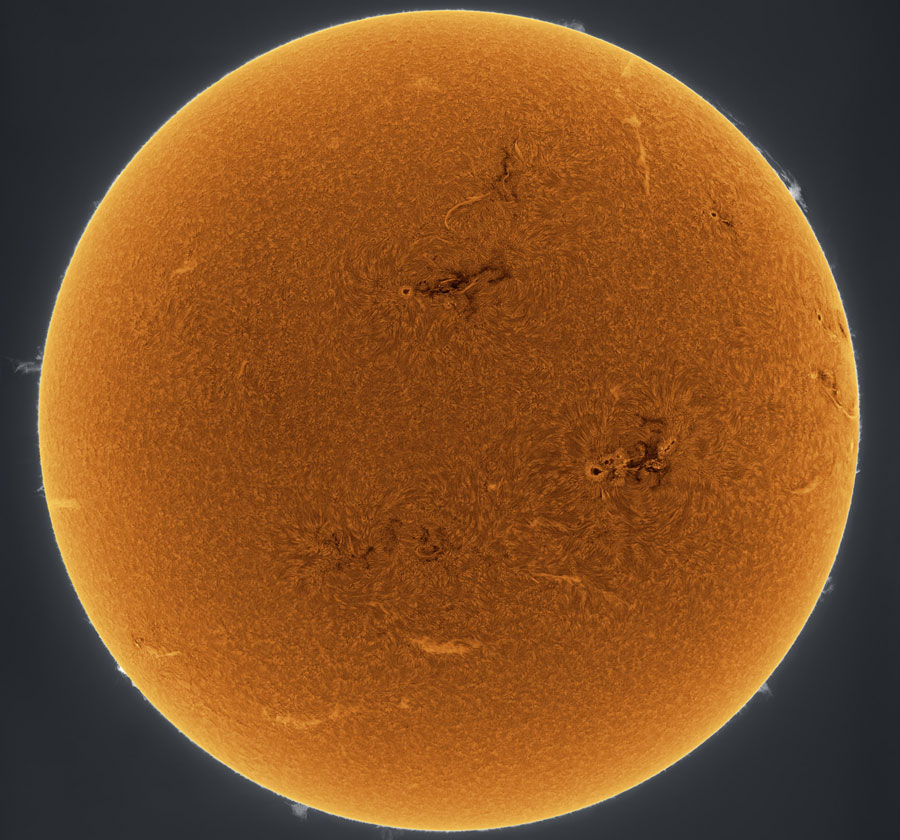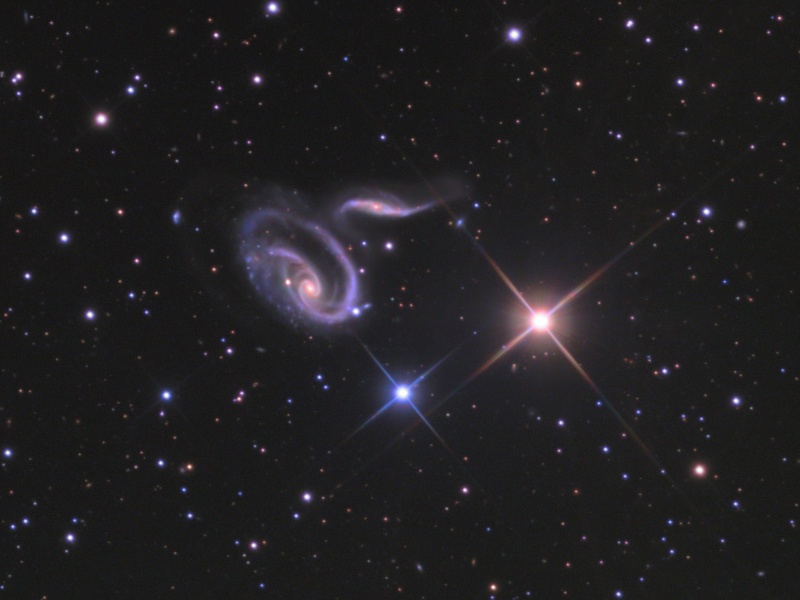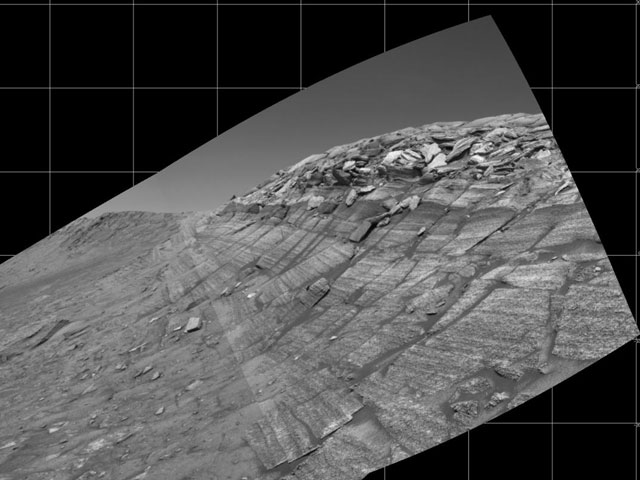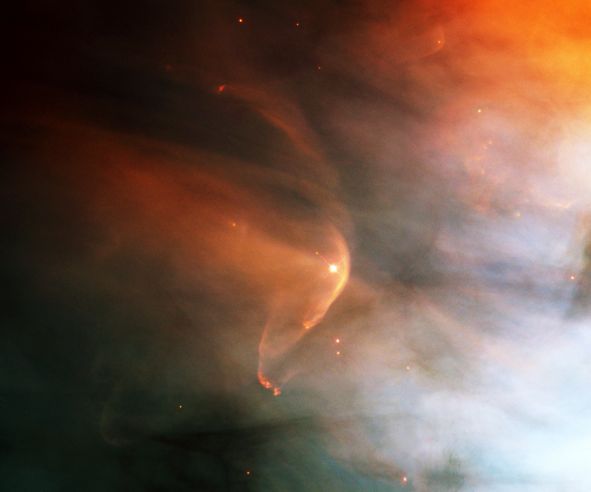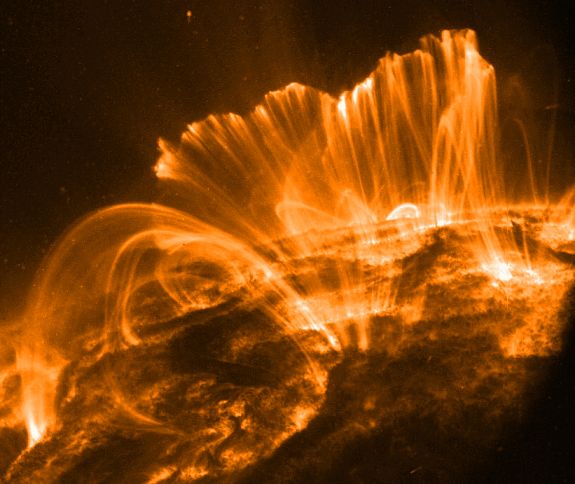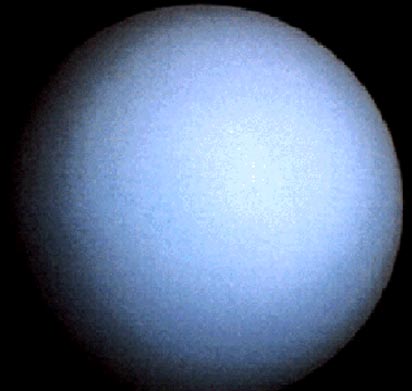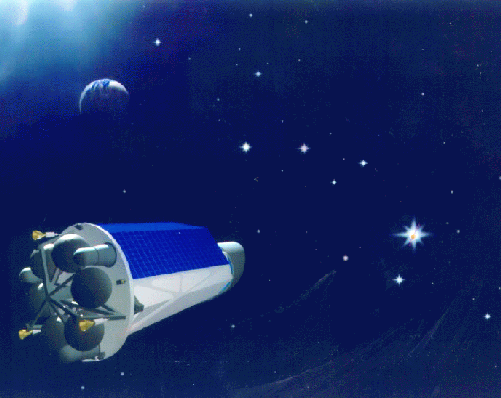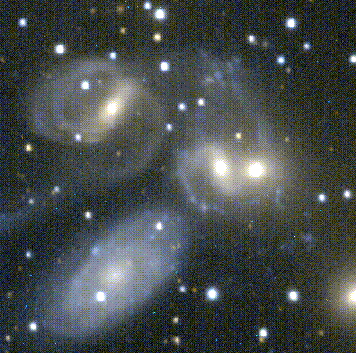| << Previous | Index | Next >> |
2014 Framing a bright emission region this telescopic view looks out along the plane of our Milky Way Galaxy toward the nebula rich constellation Cygnus the Swan. Popularly called the Tulip Nebula the glowing cloud of interstellar gas and dust is also found in the 1959 catalog by astronomer Stewart Sharpless as Sh2-101. About 8,000 light-years distant and 70 light-years across the complex and beautiful nebula blossoms at the center of this composite image. Red, green, and blue hues map emission from ionized sulfur, hydrogen, and oxygen atoms. Ultraviolet radiation from young, energetic stars at the edge of the Cygnus OB3 association, including O star HDE 227018, ionizes the atoms and powers the emission from the Tulip Nebula. HDE 227018 is the bright star very near the blue arc at the cosmic tulip's center. Glowing across the electromagnetic spectrum, microquasar Cygnus X-1 and a curved shock front created by its powerful jets lie toward the top and right.
2013 In a flash, the visible spectrum of the Sun changed from absorption to emission on November 3rd, during the brief total phase of a solar eclipse. That fleeting moment is captured by telephoto lens and diffraction grating in this well-timed image from clearing skies over Gabon in equatorial Africa. With overwhelming light from the Sun's disk blocked by the Moon, the normally dominant absorption spectrum of the solar photosphere is hidden. What remains, spread by the diffraction grating into the spectrum of colors to the right of the eclipsed Sun, are individual eclipse images at each wavelength of light emitted by atoms along the thin arc of the solar chromosphere. The brightest images, or strongest chromospheric emission lines, are due to Hydrogen atoms that produce the red hydrogen alpha emission at the far right and blue hydrogen beta emission to the left. In between, the bright yellow emission image is caused by atoms of Helium, an element only first discovered in the flash spectrum of the Sun.
2012 This month's New Moon brought a total solar eclipse to parts of planet Earth on November 13 (UT). Most of the total eclipse track fell across the southern Pacific, but the Moon's dark umbral shadow began its journey in northern Australia on Wednesday morning, local time. From along the track, this telescopic snapshot captures the Moon's silhouette in skies over Queensland along the Mulligan highway west of Port Douglas. Almost completely covered, the Sun's disk is seen still surrounded by a hint of the faint solar corona. Planet-sized prominences stretch above the active Sun's edge. Sunlight streaming through gaps in the rugged profile of the lunar limb creates the brilliant but fleeting Baily's Beads.
2011 Our Sun is becoming a busy place. Taken just last week, the Sun was captured sporting numerous interesting features including one of the larger sunspot groups yet recorded: AR 1339 visible on the image right. Only last year, the Sun was emerging from an unusually quiet Solar Minimum that lasted for years. The above image was recorded in a single color of light called Hydrogen Alpha, inverted, and false colored. Spicules cover much of the Sun's face. The gradual brightening towards the Sun's edges is caused by increased absorption of relatively cool solar gas and called limb darkening. Just over the Sun's edges, several scintillating prominences protrude, while prominences on the Sun's face are seen as light streaks. Possibly the most visually interesting of all are the magnetically tangled active regions containing cool sunspots. As our Sun's magnetic field winds toward Solar Maximum over the next few years, increased activity will likely create times when the Sun's face is even more complex.
2010 There's no place like home. Peering out of the windows of the International Space Station (ISS), astronaut Tracy Caldwell Dyson takes in the planet on which we were all born, and to which she would soon return. About 350 kilometers up, the ISS is high enough so that the Earth's horizon appears clearly curved. Astronaut Dyson's windows show some of Earth's complex clouds, in white, and life giving atmosphere and oceans, in blue. The space station orbits the Earth about once every 90 minutes. It is not difficult for people living below to look back toward the ISS. The ISS can frequently be seen as a bright point of light drifting overhead just after sunset. Telescopes can even resolve the overall structure of the space station. The above image was taken in late September from the ISS's Cupola window bay. Dr. Dyson is a lead vocalist in the band Max Q.
2009 It looks like a ring on the sky. Hundreds of years ago astronomers noticed a nebula with a most unusual shape. Now known as M57 or NGC 6720, the gas cloud became popularly known as the Ring Nebula. It is now known to be a planetary nebula, a gas cloud emitted at the end of a Sun-like star's existence. As one of the brightest planetary nebula on the sky, the Ring Nebula can be seen with a small telescope in the constellation of Lyra. The Ring Nebula lies about 4,000 light years away, and is roughly 500 times the diameter of our Solar System. In this picture by the Hubble Space Telescope in 1998, dust filaments and globules are visible far from the central star. This helps indicate that the Ring Nebula is not spherical, but cylindrical.
2008 The two prominent stars in the foreground of this colorful skyscape are well within our own Milky Way Galaxy. Their spiky appearance is due to diffraction in the astronomer's telescope. But the two eye-catching galaxies in view lie far beyond the Milky Way, at a distance of about 200 million light-years. Their distorted appearance is due to gravitational tides as the pair engage in close encounters. From our perspective, the bright cores of the galaxies are separated by about 80,000 light-years. Cataloged as Arp 273 (also as UGC 1810), the galaxies do look peculiar, but interacting galaxies are now understood to be common in the universe. In fact, the nearby large spiral Andromeda Galaxy is known to be some 2 million light-years away and approaching the Milky Way. Arp 273 may offer an analog of their far future encounter. Repeated galaxy encounters on a cosmic timescale can ultimately result in a merger into a single galaxy of stars.
2007 M13 is modestly recognized as the Great Globular Cluster in Hercules. A system of stars numbering in the hundreds of thousands, it is one of the brightest globular star clusters in the northern sky. At a distance of 25,000 light-years, the cluster stars crowd into a region 150 light-years in diameter, but approaching the cluster core over 100 stars would be contained in a cube just 3 light-years on a side. For comparison, the closest star to the Sun is over 4 light-years away. This stunning view of the cluster combines recent telescopic images of the cluster's dense core with digitized photographic plates recorded between 1987 and 1991 using the Samuel Oschin Telescope, a wide-field survey instrument at Palomar Observatory. The resulting composite highlights both inner and outer reaches of the giant star cluster. Among the distant background galaxies also visible, NGC 6207 is above and to the left of the Great Globular Cluster M13.
2006 Is that white arch real? What is being seen is a fogbow, a reflection of sunlight by water drops similar to a rainbow but without the colors. The fog itself is not confined to an arch -- the fog is mostly transparent but relatively uniform. The fogbow shape is created by those drops with the best angle to divert sunlight to the observer. The fogbow's relative lack of colors are caused by the relatively smaller water drops. The drops active above are so small that the quantum mechanical wavelength of light becomes important and smears out colors that would be created by larger rainbow water drops acting like small prisms reflecting sunlight. The above striking image of a fogbow was taken last week with the Sun behind the photographer. Close inspection of the far right of the full image will show one of the two suspension towers of the Golden Gate Bridge in California, USA.
2005 Have you ever seen a very bright meteor? Unexpected, this year's Taurid meteor shower resulted in numerous reports of very bright fireballs during the nights surrounding Halloween. Pictured above, a fireball that momentarily rivaled the brightness of the full Moon was caught over Cerro Pachon, Chile by a continuous sky monitor on November 1. Several bright Taurid fireballs are identifiable on the sky movie for that night. The above image is a digitally rectangled version of a circular fisheye frame and shows the entire sky, horizon to horizon. The bright meteor was seen swooping between the directions of the Large and Small Magellanic Clouds. The band of the Milky Way Galaxy crosses the horizon behind the dome of the 8-meter Gemini South Telescope. Taurid meteor fireballs are likely pebble sized debris left by Comet Encke. Over the next week the Leonids meteor shower will peak, although they will need to be seen through the glare of a nearly full Moon. [Disclosure: Robert Nemiroff collaborates on both the Astronomy Picture of the Day and the Night Sky Live projects.]
2004 The majestic walls of Endurance Crater contain layers of clues about the ancient past of Mars. In fact, the deeper the layer, the older the clue. The particular crater wall imaged above was dubbed Burns Cliff and was in front of the robot rover Opportunity last week. Close inspection of different layers has found slightly different compositions as well as interesting trends in relative compositions. For example, deeper layers contain similarly decreasing amounts of both magnesium and sulfur, indicating a common reason for their decline -- possibly dissolution in water. Today, more practically, Burns Cliff blocks one exit direction for Opportunity to leave Endurance Crater. When combined with slippery sand elsewhere on the crater floor, controllers have decided to program Opportunity to back out of the crater the way it came in - after a few more days exploration.
2003 This arcing, graceful structure is actually a bow shock about half a light-year across, created as the wind from young star LL Orionis collides with the Orion Nebula flow. Adrift in Orion's stellar nursery and still in its formative years, variable star LL Orionis produces a wind more energetic than the wind from our own middle-aged sun. As the fast stellar wind runs into slow moving gas a shock front is formed, analogous to the bow wave of a boat moving through water or a plane traveling at supersonic speed. The slower gas is flowing away from the Orion Nebula's hot central star cluster, the Trapezium, located off the lower right hand edge of the picture. In three dimensions, LL Ori's wrap-around shock front is shaped like a bowl that appears brightest when viewed along the "bottom" edge. The complex stellar nursery in Orion shows a myriad of similar fluid shapes associated with star formation, including the bow shock surrounding a faint star at the upper right. Part of a mosaic covering the Great Nebula in Orion, this composite color image was recorded in 1995 by the Hubble Space Telescope.
2002 Spanning southern to northern skies, stars trail across this panoramic view of the African night from equatorial Kenya. The three hour long exposure was made on a clear, dark, mid November evening facing due west and covers just over 180 degrees along the horizon. So, the South Celestial Pole is at the center of the concentric arcs on the left and the North Celestial Pole is at the far right (scroll right). And, you guessed it(!), the stars setting along the Celestial Equator leave the straight trails near the middle of the picture. Well illustrated in this thoughtfully composed panorama, the star trails in the African night are, of course, not due to motions of the individual stars but simply reflect the daily rotation of planet Earth itself.
2001 Twenty years ago this week, the Space Shuttle Columbia became the first reusable spaceship. Its second trip to low Earth orbit and back again began on November 12, 1981, following its maiden voyage by only seven months. Seen above Columbia, 56 meters (184 feet) long with a 24 meter (78 foot) wingspan, is launched mated to an external fuel tank and two solid rocket boosters producing dramatic exhaust plumes. The solid rocket boosters, one on each side of the external tank, provide most of the thrust in the first 2 minutes after launch and are then jettisoned for later recovery. Supplying the main shuttle engines during liftoff, the external fuel tank separates after about 8 minutes. The largest shuttle element not recycled for a future flight, the external tank falls back toward Earth breaking up and descending into a remote ocean area. Still the oldest operating shuttle, Columbia is pictured here in June of 1992 rocketing toward a cloud bank on its twelfth flight. Officially designated OV-102, Columbia is fittingly named after the 18th century sailing vessel which became the first American ship to circumnavigate planet Earth.
2000 In this picture, the Sun's surface is quite dark. A frame from a movie recorded on November 9th by the orbiting TRACE telescope, it shows coronal loops lofted over a solar active region. Glowing brightly in extreme ultraviolet light, the hot plasma entrained above the Sun along arching magnetic fields is cooling and raining back down on the solar surface. Hours earlier, on November 8th, astronomers had watched this particular active region produce a not so spectacular solar flare. Still, the M-class flare spewed forth an intense storm of particles, suddenly showering satellites near the Earth with high energy protons. The flare event was also associated with a large coronal mass ejection, a massive cloud of material which impacted our fair planet's magnetic field about 31 hours later. The result ... a strong geomagnetic storm.
1999
1998 Mars has two tiny moons, Phobos and Deimos. Pictured above is Deimos, the smaller moon of Mars. In fact, Deimos is one of the smallest known moons in the Solar System measuring only 9 miles across. The diminutive Martian moons were discovered in 1877 by Asaph Hall, an American astronomer working at the US Naval Observatory in Washington D.C. The existence of two Martian moons was predicted around 1610 by Johannes Kepler, the astronomer who derived the laws of planetary motion. In this case, Kepler's prediction was not based on scientific principles, but his writings and ideas were so influential that the two Martian moons are discussed in works of fiction such as Jonathan Swift's "Gulliver's Travels", written in 1726, over 150 years before their actual discovery.
1997 Uranus is the third largest planet after Jupiter and Saturn. This picture was snapped by the Voyager 2 spacecraft in 1986 - the only spacecraft ever to visit Uranus. Uranus has many moons and a ring system. Uranus is composed mostly of rock and ices, but with a thick hydrogen and helium atmosphere. Uranus is peculiar in that its rotation axis is greatly tilted and sometimes points near the Sun. It remains an astronomical mystery why Uranus' axis is so tilted. Uranus and Neptune are very similar.
1996 Observational astronomy has recently provided evidence of the existence of massive Jupiter-sized planets orbiting distant suns, protoplanetary disks of gas and dust surrounding newly formed stars, and planetary bodies orbiting exotic stellar corpses known as pulsars. Indeed, the formation of planets seems to be a broader and more varied phenomenon than previously imagined. Are there nearby solar systems with Earth-sized planets as well? Many would answer yes, but small, relatively low mass planets orbiting sunlike stars - which might be capable of supporting life - are extremely difficult to detect. One possible approach to this daunting observational problem is to regularly monitor the light from many solar-type stars, searching for the slight decrease in brightness which signals the transit of a small planet in front of the stellar disk. A proposal for a space-based instrument to engage in such a program, the Kepler Mission, is illustrated above. In this concept, the monitoring space telescope orbits the Sun, slowly drifting away from Earth. The goal of this mission would be to discover Earth-sized planets in the habitable zone of solar-type stars, taking a step toward answering the profound question - Does life exist on other worlds beyond our Solar System?
1995 Five closely grouped galaxies are visible in this image made using the Kitt Peak National Observatory 2.1 meter telescope. The grouping is commonly known as Stephan's Quintet. Four of the galaxies show essentially the same redshift suggesting that they are at the same distance from us. The large bluish spiral below and left of center actually has a smaller redshift than the others, indicating it is much closer. It is probably a foreground object which happens to lie along the line of sight to the more distant galaxies. Of the four distant galaxies, three seem to be colliding, showing serious distortions due to gravitational tidal forces. The fourth is a normal appearing elliptical galaxy (at the lower right edge of the field). Recent results suggest that collisions play an important role in the life cycles of galaxies.
| << Previous | Index | Next >> |
